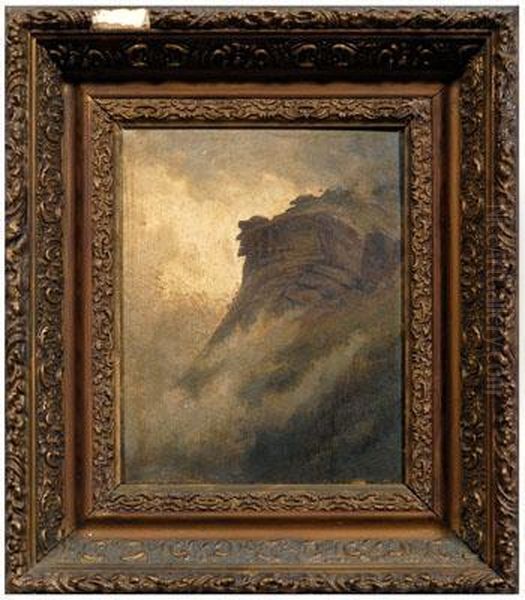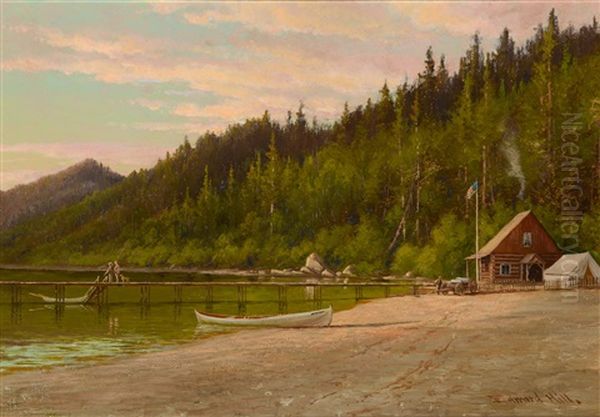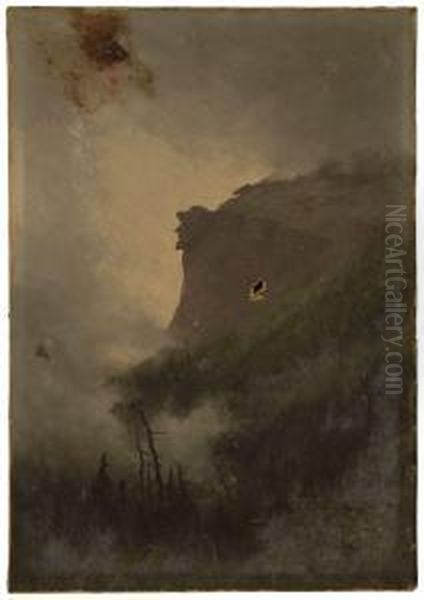Edward Hill (1843-1923) stands as a notable figure among the artists who sought to capture the sublime beauty and rugged character of the American landscape during the latter half of the 19th century. Born in England, Hill immigrated to the United States, eventually settling in New Hampshire, a state whose dramatic scenery would become the cornerstone of his artistic oeuvre. His work is firmly rooted in the traditions of the Hudson River School, yet it possesses a distinct character shaped by his personal connection to the regions he depicted, particularly the majestic White Mountains.
Transatlantic Beginnings and American Focus
Born in Wolverhampton, Staffordshire, England, on December 9, 1843, Edward Hill was part of an artistically inclined family. His father, Thomas Hill (not to be confused with the more famous American landscape painter of the same name), was a tailor by trade but also a painter. Several of Edward's siblings also pursued artistic careers, most notably Thomas Hill (1829-1908), who would become renowned for his grand depictions of the American West, particularly Yosemite Valley, and his younger brother, John Henry Hill (though less famous). The family immigrated to the United States in 1844, settling in Taunton, Massachusetts. This familial environment undoubtedly nurtured young Edward's artistic inclinations from an early age.
His early training likely came from within the family, particularly from his older brother Thomas, who had already established himself as an artist. The artistic currents of the mid-19th century in America were heavily influenced by the Hudson River School, a movement that celebrated the American wilderness as a source of national pride and spiritual renewal. Artists like Thomas Cole, Asher B. Durand, and Frederic Edwin Church had laid the groundwork, inspiring a generation to venture into nature and translate its grandeur onto canvas with meticulous detail and a sense of awe.
The Lure of the White Mountains

While the Hudson River School artists initially focused on the Catskills and the Hudson River Valley, their quest for new, inspiring landscapes soon led them northward to the White Mountains of New Hampshire. By the time Edward Hill was developing his artistic voice, this region had become a major hub for landscape painters. The area offered a compelling mix of towering peaks, deep valleys, pristine lakes, and dramatic weather, providing endless subject matter. Artists like Benjamin Champney, a pioneer of White Mountain art, had already popularized the area, establishing studios in North Conway and attracting other painters.
Edward Hill was profoundly drawn to this region. He spent considerable time in and around the White Mountains, particularly in areas like Franconia Notch, Crawford Notch, and the Presidential Range. His deep affection for New Hampshire was not merely that of a detached observer; Hill was an avid outdoorsman, known for his enthusiasm for hiking and fishing. These activities provided him with an intimate knowledge of the landscape, its moods, and its subtle details, which he then translated into his paintings. He established a studio in Lancaster, New Hampshire, and later in Bethlehem, making the state his primary base for much of his career.
Artistic Style: Hudson River School and Romantic Realism
Edward Hill's artistic style is most accurately categorized within the later phase of the Hudson River School. His works exhibit the school's characteristic attention to detail, realistic rendering of natural forms, and often, a luminous quality in the depiction of light and atmosphere. Like his contemporaries, Hill aimed to capture not just the physical appearance of the landscape but also its inherent majesty and the emotional response it evoked. This aligns with the Romantic sensibilities that underpinned the Hudson River School, viewing nature as a manifestation of the divine or a source of profound spiritual experience.
His paintings often feature a careful balance between the grandeur of the overall scene and the specific details of flora, fauna, and geological formations. While artists like Albert Bierstadt, a contemporary known for his monumental canvases of the American West, often emphasized the epic scale, Hill's New Hampshire scenes, while majestic, often retained a sense of intimacy and accessibility. He was adept at capturing the changing seasons, from the vibrant hues of autumn foliage to the stark, crisp beauty of winter.

A notable aspect of Hill's work, as mentioned in historical accounts, is a fusion of "commercial and Romantic elements." This likely refers to the practical reality for many artists of his time who needed to create works that appealed to a growing tourist market in areas like the White Mountains. Hotels and resorts often commissioned or purchased paintings, and visitors sought scenic souvenirs. Hill managed to cater to this demand while still imbuing his works with genuine artistic integrity and a Romantic appreciation for nature. His paintings were not mere topographical records; they were interpretations filtered through his artistic vision and love for the land.
Themes and Subjects: Beyond the Grand Landscape
While grand vistas of mountains, lakes, and forests formed the core of Edward Hill's output, he also explored other subjects that provided a fuller picture of life in New England. He was known to paint genre scenes, depicting everyday activities and the human presence within the landscape. Among these, his depictions of winter logging operations are particularly noteworthy. These scenes offer a glimpse into the working lives of New Englanders and the interaction between humanity and the often-harsh natural environment. Such works demonstrate his versatility and his interest in capturing the multifaceted character of the region.
His passion for the outdoors directly informed these themes. His experiences hiking and fishing allowed him to observe the landscape from perspectives not available to the casual visitor. This intimate familiarity is evident in the authenticity of his depictions, whether it's the play of light on a trout stream or the specific character of a mountain trail. His works often invite the viewer to step into the scene, to feel the crisp mountain air or the quiet solitude of a forest interior.
Representative Works and Their Characteristics
Identifying specific, universally acclaimed "masterpieces" by Edward Hill can be challenging, as his reputation, while solid, is perhaps more regional than that of some of his towering contemporaries like Church or Bierstadt. However, his body of work collectively represents a significant contribution to American landscape painting. His representative works are primarily his numerous views of the White Mountains. Titles often reflect the specific locations depicted, such as "Mount Washington from the Saco," "Franconia Notch," "Echo Lake," or "Profile Lake."
These paintings typically showcase his skill in rendering atmospheric perspective, creating a sense of depth and distance. His handling of light is often a key feature, whether it's the golden glow of late afternoon sun on a mountain peak or the soft, diffused light of an overcast day. His autumn scenes are particularly celebrated for their vibrant, yet harmonious, color palettes. The "winter logging" scenes, as mentioned, stand out for their narrative quality and their depiction of human endeavor.

His art, while adhering to the realistic tenets of the Hudson River School, also possessed a unique perspective. Some accounts mention a "humorous" touch in his depictions of daily activities, suggesting an ability to find charm and character in the ordinary aspects of life, alongside the sublime. This blend of the grand and the everyday, the romantic and the relatable, defines much of his appeal.
Context: The Broader World of 19th-Century American Art
Edward Hill worked during a dynamic period in American art. The Hudson River School, in its first generation led by Thomas Cole and Asher B. Durand, had established landscape painting as a preeminent American art form. The second generation, which included artists like Frederic Edwin Church, Albert Bierstadt, Sanford Robinson Gifford, John Frederick Kensett, and Martin Johnson Heade, expanded the geographical scope and often pushed the boundaries of scale and atmospheric effects, leading to the development of Luminism.
Hill was a contemporary of these second-generation figures. While he may not have achieved the same level of national fame as Church or Bierstadt, his dedication to the New England landscape, particularly the White Mountains, places him firmly within an important regional offshoot of the Hudson River School, often referred to as the "White Mountain School" of painters. This group included artists such as Benjamin Champney, Frank Shapleigh, Samuel Lancaster Gerry, Alfred Thompson Bricher, and his own brother, Thomas Hill (before Thomas moved West). These artists, while sharing the general philosophy of the Hudson River School, developed a specific focus on the unique character of the New Hampshire wilderness.
The latter part of Hill's career saw the rise of new artistic movements, such as Tonalism, championed by artists like George Inness (who himself had earlier Hudson River School roots) and James McNeill Whistler, and American Impressionism, with figures like Childe Hassam and Theodore Robinson. While Hill remained largely faithful to his Hudson River School style, the changing artistic landscape would have formed the backdrop to his later years. His commitment to a detailed, romantic realism provided a contrast to these emerging, more abstract or impressionistic approaches.
Later Life and Artistic Legacy
Edward Hill continued to paint throughout his life, maintaining his connection to New Hampshire. He exhibited his work at various venues, including the Boston Art Club and the National Academy of Design. While he also painted in other locations, including possibly some Western scenes (perhaps influenced by his brother Thomas), the White Mountains remained his most enduring muse.
His legacy is that of a dedicated and skilled chronicler of the New England landscape. His paintings offer valuable historical and artistic insights into how 19th-century Americans viewed and valued their natural environment. They capture a sense of wonder and appreciation for a wilderness that was, even then, beginning to feel the pressures of development and tourism. His works are held in various public and private collections, particularly in New England, and continue to be appreciated for their beauty, detail, and evocative power.
Edward Hill passed away on August 27, 1923, in Hood River, Oregon, possibly while visiting family or exploring new landscapes, though his artistic heart remained firmly in the mountains of New Hampshire. His contributions ensure his place among the significant figures of the White Mountain School and as a steadfast practitioner of the Hudson River School tradition, leaving behind a visual legacy that continues to celebrate the enduring allure of the American wilderness. His paintings serve as a testament to an era when art played a crucial role in shaping a young nation's identity through its engagement with the natural world.